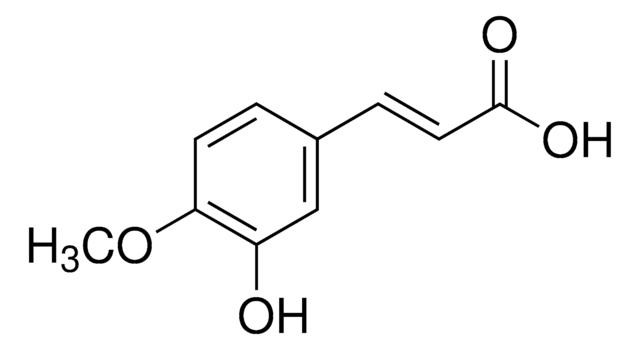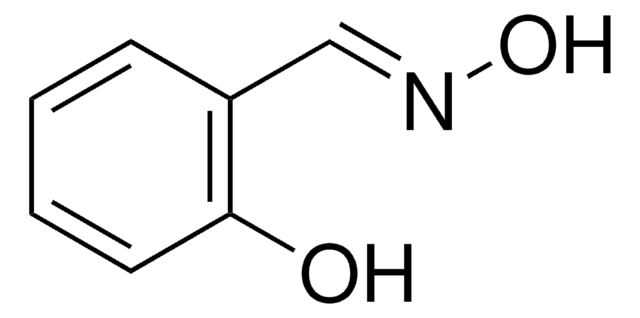103012
3-Hydroxy-4-methoxycinnamic acid, predominantly trans
97%
Iniciar sesiónpara Ver la Fijación de precios por contrato y de la organización
About This Item
Fórmula lineal:
HOC6H3(OCH3)CH=CHCO2H
Número de CAS:
Peso molecular:
194.18
EC Number:
MDL number:
UNSPSC Code:
12352100
PubChem Substance ID:
NACRES:
NA.22
Productos recomendados
assay
97%
form
solid
mp
230 °C (dec.) (lit.)
SMILES string
COc1ccc(\C=C\C(O)=O)cc1O
InChI
1S/C10H10O4/c1-14-9-4-2-7(6-8(9)11)3-5-10(12)13/h2-6,11H,1H3,(H,12,13)/b5-3+
InChI key
QURCVMIEKCOAJU-HWKANZROSA-N
Categorías relacionadas
General description
3-Hydroxy-4-methoxycinnamic acid, predominantly trans is available as white crystals. 3-Hydroxy-4-methoxycinnamic acid is isolated from the aerial part of Artemisia capillaris, Chinese medicinal plant. It is a component of chinese herbal medicine used for a pain killer and stomachic. It is an efficient acetylcholine inhibitor. 3-Hydroxy-4-methoxycinnamic acid is bioactive metabolite of Spilanthes acmella Murr. It increases the resistance of low-density lipoprotein (LDL) to oxidation.
Application
3-Hydroxy-4-methoxycinnamic acid was used in the synthesis of tranilast and various tranilast analogs (cinnamoyl anthranilates) by genetically engineered Saccharomyces cerevisiae yeast strain. It was also used in the synthesis of glycoside compounds by undergoing glycosidation.
Storage Class
11 - Combustible Solids
wgk_germany
WGK 2
ppe
dust mask type N95 (US), Eyeshields, Gloves
Elija entre una de las versiones más recientes:
¿Ya tiene este producto?
Encuentre la documentación para los productos que ha comprado recientemente en la Biblioteca de documentos.
Los clientes también vieron
Supaluk Prachayasittikul et al.
Molecules (Basel, Switzerland), 14(2), 850-867 (2009-03-04)
Spilanthes acmella Murr. (Compositae) has been used as a traditional medicine for toothache, rheumatism and fever. Its extracts had been shown to exhibit vasorelaxant and antioxidant activities. Herein, its antimicrobial, antioxidant and cytotoxic activities were evaluated. Agar dilution method assays
T S Wu et al.
Bioorganic & medicinal chemistry, 9(1), 77-83 (2001-02-24)
Five new constituents including a flavonoid, artemisidin A (1), and four coumarins, artemicapins A (2), B (3), C (4) and D (5), together with 70 known compounds (6-75), have been isolated and characterized from the aerial part of Artemisia capillaris.
Mathieu Renouf et al.
The Journal of nutrition, 140(2), 259-263 (2009-12-17)
Chlorogenic acids (CGA) are antioxidants found in coffee. They are becoming of interest for their health-promoting effects, but bioavailability in humans is not well understood. We hypothesized that adding whole milk or sugar and nondairy creamer to instant coffee might
I-Min Liu et al.
The Journal of pharmacology and experimental therapeutics, 307(3), 1196-1204 (2003-09-17)
We investigated the mechanism(s) by which isoferulic acid lowers plasma glucose levels in streptozotocin-induced diabetic rats (STZ-diabetic rats). In STZ-diabetic rats, isoferulic acid dose dependently lowered plasma glucose concentrations and increased plasma beta-endorphin-like immunoreactivity (BER). Both of these effects of
I M Liu et al.
British journal of pharmacology, 129(4), 631-636 (2000-02-22)
Wistar rats with streptozotocin-induced diabetes (STZ-diabetic rats), which is similar to human insulin-dependent diabetic mellitus (IDDM), were employed to investigate the antihyperglycemic action of isoferulic acid. A single intravenous injection of isoferulic acid decreased the plasma glucose in a dose-dependent
Nuestro equipo de científicos tiene experiencia en todas las áreas de investigación: Ciencias de la vida, Ciencia de los materiales, Síntesis química, Cromatografía, Analítica y muchas otras.
Póngase en contacto con el Servicio técnico







